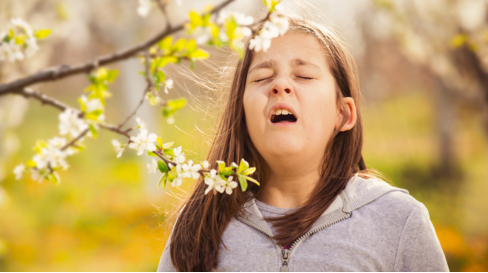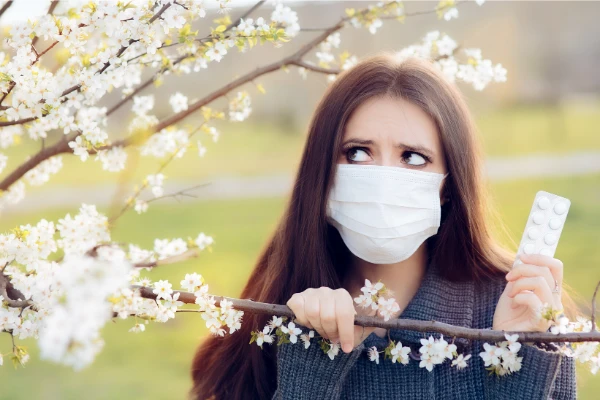Spring Allergies
Causes, Symptoms, Treatment, and Side Effects of Spring Allergies
Spring Allergies Overview
Spring is a lovely time of the year. However, it may not be for everyone. Especially not for those who suffer from spring allergies. Blooming flowers and sprouting trees release pollen that causes millions of people with seasonal allergies to sniff and sneeze. The seasonal allergy or hay fever may cause eye irritation, nasal irritation, respiratory irritation, skin irritation or digestive irritation. Spring allergies are triggered in the spring from early February until summer.

Causes of Spring Allergies
The main cause for spring allergy is pollen. Trees, grasses and weeds release these tiny substances into the air for pollination. When this pollen gets in contact with people who are sensitive to them, they may have attacks of pollen allergy.
Pollens are recognized as a dangerous sign (allergens) for people allergic to them, and their immune system starts releasing antibodies. These antibodies will cause histamines to be released from mast cells into the bloodstream and start to show various allergic symptoms.
Pollens from trees, grasses and weeds travel far distances and can reach you even if you don’t have such plants in your backyard. Some common spring allergy plants are:
Trees
- Alder
- Ash
- Aspen
- Beech
- Boxelder
- Cedar
- Cottonwood
- Cypress
- Elm
- Hickory
- Juniper
- Maple
- Mulberry
- Oak
- Olive
- Palm
- Pine
- Poplar
- Sycamore
- Willowthe
Grasses and weeds:
- Bermuda
- Fescue
- Johnson
- June
- Orchard
- Perennial rye
- Redtop
- Saltgrass
- Sweet vernal
- Timothy
If you are sensitive to spring allergy, you will notice a high sensitivity on a windy day as the wind may bring along allergens to your body. Similarly, it would be least sensitive on a rainy day, as rain would wash away the allergens.
Mold
Mold, which triggers a year-round allergy, will wreak havoc in the springtime. This is particularly true when moist and rainy weather is followed by warmer weather, resulting in a high mold concentration.
Spores from mold, such as yeast and mildew, are also carried by the wind. During the spring season, they increase in the outside air and cause the worst symptoms in patients allergic to them.
Some from many outdoor molds are:
- Alternaria
- Cladosporium
- Hormodendrum
Some indoor molds can also trigger you at home, such as:
- Aspergillus
- Penicillium
They show the same symptoms as other spring allergens do.
Symptoms of Spring Allergies
Some of the most familiar spring allergy symptoms are:
- Red, itchy and watery eyes
- Sneezing and nose irritation
- runny nose
- irritation in eyes, nose, ears, and mouth
- stuffy nose due to congestion
- skin irritation/allergy
- puffy eyes
- post-nasal drip, a sensation of mucus dripping at the back of the throat
- some may get hives
- coughing, wheezing, or difficulty breathing in severe symptoms

Preventing Spring Allergies
To prevent triggering spring allergy, one should prevent exposure to the causes of spring allergies, i.e. pollen and mold.
- If pollen levels are high outside, try to remain indoors. You can get the pollen counts checked according to your states through the internet
- Keep your garden grass as short as possible during the springs
- If you need to go outside, use a dust mask. Also, use a mask while mowing the lawn or gardening
- Use air conditions or allergy-friendly filters while keeping your windows closed
- Keep your yard clean from dead and rotting logs
- When exposed to the outer air, wash your hair and bathe to remove pollen
- Change and wash bed linen once a week or more often
- Dry your clothes indoors or in a dryer instead of outdoors
- Remove your shoes before getting into the house
- Use hats and sunglasses to limit pollen entering your eyes and getting in your hair
- Vacuum carpets and floors once a week or more
Spring Allergy Treatments
Spring allergy treatment includes medications as well as some home remedies. Let us have a look into these:
Medication
There are various over the counter or prescribed medications available to treat spring allergy symptoms.
Antihistamines: These are used to relieve symptoms such as itchy and watery eyes and nose, runny nose and sneezing. These may be available in the form of tablets, nasal sprays or liquid.
Corticosteroids: These are considered the most effective medications for allergic rhinitis. It helps by reducing inflammation and may be used as a nasal spray, inhaler, or pills.
Decongestions: These minimize stuffiness by shrinking the lining of the nasal passages. Decongestants are available as pills, liquids, drops, and nasal sprays. Long-term use may have negative consequences.
Leukotriene receptors antagonists: These are tablets that block the action of various chemicals that cause allergic reactions in people.
Eye drops: Eye drops may be used for treating eye allergies due to pollen and molds. They can provide temporary relief from redness, itchiness and swelling in the eyes.
Immunotherapy is a long-term cure that helps to soothe people from allergies. Physicians can use immunotherapy to treat patients who are experiencing side effects or who are getting little to no benefit from medications.
Allergy shots and sublingual tablets are two forms of immunotherapy. These allergy shots are given for up to 3 to 5 years. It provides resistance from allergens. Sublingual tablets can handle only a few forms of allergies. The affected person may be taking the pills that dissolve under their tongue from spring to the leading months.
Home Remedies
Natural or home remedies may bring comfort to people suffering from spring allergies. These remedies may include:
Steam inhalation
Inhaling steam can open up the nasal passages and soothe people from allergic rhinitis symptoms. If you don’t have a steamer, you can place a container of boiling water on the table. Cover your head, face and container with a towel and inhale the steam.
Saline solution
Using saline rinse relieves stuffy nose and congestion by removing extra mucus from the nasal passage. This solution can also wash out allergens from the nose and sinuses. You can get various saline solutions without a prescription.
Conclusion
Spring allergies may cause severe allergic reactions. However, if proper on time prevention and precautions are considered, one may be able to reduce the symptoms. Once an attacked has occurred, you should consult your doctor and use proper medications to avoid serious health conditions.
Written by: Madiha Ather Hashmi (April 01, 2021)
Sources
- Nayana Ambardekar, MD (2020) “How to Handle Your Spring Allergies”. WebMD, LLC
https://www.webmd.com/allergies/spring-allergies - Mayo Clinic Staff (2020) “Seasonal allergies: Nip them in the bud”. Mayo Foundation for Medical Education and Research (MFMER)
https://www.mayoclinic.org/diseases-conditions/hay-fever/in-depth/seasonal-allergies/art-20048343 - Anna Smith (2020) “Spring allergies: Types, symptoms, and treatments”. Healthline Media
https://www.medicalnewstoday.com/articles/sinus-flush#benefits
Medically Reviewed By

Alexandria University Hospital
I have reviewed the articles on seasonalallergies.org and I would like to say that I was very surprised.
Over years, I have seen many different articles in the field of allergy, but these articles were very interesting.
These articles were really unique, they could help many people around the world to know more about seasonal allergy, symptoms, prevention and when to seek medical advice.
These articles represent an addition in the field of Health Education not only for people with allergy but also for the whole population.
Looking for more allergy types? Find a full list of other allergy types here.
Last Updated on July 5, 2023